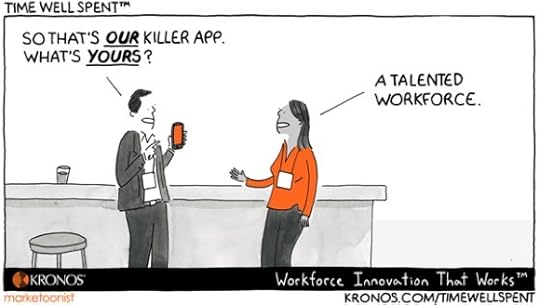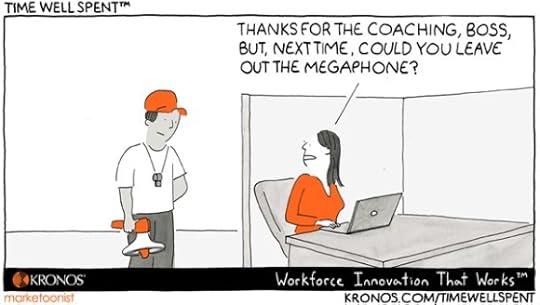Sharlyn J. Lauby's Blog, page 132
August 13, 2017
What You Can Do If the Boss You Like is Quitting
Often, we talk about the bosses we don’t like and the things we hate about them. When they resign (or get fired), our reaction is “Yippee!” But what about the bosses we do like? The ones who are great. They recognize, coach, and support us and our career development. Now they’re quitting!
I saw an article over at The Muse titled, “The Smartest Steps to Take if You Think Your Boss Is Quitting”. It’s worth checking out. Keep in mind that your boss could be looking for a new opportunity for the same reasons you are – closer commute, more pay, better benefits, greater work/life balance, and the list goes on. Workers are quitting at the fastest pace in 16 years.
So, it’s not out of the realm of possibility that the wonderful terrific boss you have might come into work one day with their resignation letter. If that happens, here are four things to consider:
Wish them well. While you’re bummed that they’re leaving, congratulate your boss on their new opportunity. The world is too small these days. Your paths could cross again at some point. You can always stay in touch via LinkedIn, if you’re not already connected.
Don’t ask them to poach you for their new company. Your boss will have lots on their mind right now. They have to wrap up projects at their current job AND start getting ready for their new job. It would not be cool for them to have conversations with employees about quitting and applying at their new company.
Decide if you’re qualified (and willing) to take on additional responsibilities. This conversation also takes some finesse. It’s possible that, as much as you liked your boss, their resignation opens up opportunities for you. Think about whether you’re ready to express your desire for a promotion. Or maybe consider temporarily filling in until the company hires someone.
Don’t assume your next boss will be evil. If you like your boss, it’s hard to imagine another manager being better. But it does happen. Your new manager could expose you to new knowledge and skills that the old manager wasn’t capable of doing. Different management styles aren’t bad. They’re just different.
The final thing I’d suggest to anyone who really likes their manager is tell them. Don’t wait until they’re leaving to let them know. As employees, we want our managers to give us feedback about our performance and coach us to do better. There’s no business rule that says employees can’t tell their managers that they’re doing a good job.
I can’t help but wonder if managers heard from their employees that they were doing a good job, would that make the boss more engaged? If managers knew they were doing a good job, directly from employees, would that help them stay with the company?
Image captured by Sharlyn Lauby at the neon graveyard in Las Vegas, NV
The post What You Can Do If the Boss You Like is Quitting appeared first on hr bartender.






August 11, 2017
There Are Not Apps for Everything – Friday Distraction
Remember the old iPhone commercial, “There’s an app for that.”?
There are a lot of apps available to us. Apps for banking, well-being, photography, and of course, games. It could be said that we’ve become an app driven society. And that might not be a bad thing. Apps can really help us in our personal and professional lives.
But today’s Time Well Spent cartoon from our friends at Kronos reminded me that apps can’t do everything.
While an app can provide us with certain amount of information and enjoyment, people are still a key differentiator in business. I don’t ever recall a time when I decided to do business with an organization solely because they have an app. Sure, an app might be nice but the people I interact with create the memory and the credibility of the company.
Businesses need to keep this in mind when it’s budget season. Sure, allocating some dollars to create or update an app is a good thing. If your competitive set has an app and you don’t, it’s something to seriously consider. If you haven’t updated your app is years, it’s time to figure out what’s in the next version.
But, organizations cannot develop apps to the exclusion of customer service. I don’t hear anyone saying, “I’d buy from XYZ Company in a heartbeat. Their customer service sucks but their app is a winner!”
Same goes for management and leadership development. Not sure I can hear employees saying, “I love working here. My manager is a jerk, but the app the company developed for employee learning is the best.”
You get my point. Apps are great. This really isn’t an anti-app post. Apps don’t replace people. And all the artificial intelligence talk in the world isn’t going to change that. At least for now.
The post There Are Not Apps for Everything – Friday Distraction appeared first on hr bartender.






August 10, 2017
Compensation Based on Your Number of Direct Reports – Ask #HR Bartender
In my professional career, I’ve found that we don’t spend enough time explaining to employees how they get paid. What I mean by that is organizations often do not share the factors that determine pay ranges, etc. Which is why employees can get confused – which leads to today’s reader note:
Hey! I have a quick (but perhaps complicated) question for you. Is there a general rule of thumb for how much additional money a manager in a corporate setting should be paid based on the number of direct reports they have? (i.e., if 3 new employees are added to a manager’s team, how much is managing each of the 3 new employees worth – aside from other responsibilities?). The example may have some grey area but I’m curious to hear what this could look like for a medium-sized company. Any help is greatly appreciated!
To help us understand employee compensation, I asked Ann Bares if she would share her expertise and, lucky for us, she said “yes”. Ann is managing partner with Altura Consulting Group and contributor to the Compensation Force and Compensation Café blogs. You might recognize her name because she’s helped us before on this post about providing your W-2 to get a job.
Ann, let’s start by covering the fundamentals of compensation. What are the individual factors that go into compensation?
 [Bares] Most companies today rely heavily – though not necessarily exclusively – on the market value of a position as the primary determinant of pay opportunity.
[Bares] Most companies today rely heavily – though not necessarily exclusively – on the market value of a position as the primary determinant of pay opportunity.
A minority of companies use actual factor-based compensation systems – which establish the value of a job by rating it against ‘compensable factors’. These typically include knowledge and experience requirements, problem solving, decision making accountability, relationships, and communication and often something that measures the ‘scope’ of the position.
With that said and referencing the reader’s note, position scope is rarely tied discretely to the number of employees except at a higher level (where we might recognize that a leader overseeing the work of 1,000 employees may have broader scope than on one overseeing 500 or fewer.
This might be a bit repetitive but, how is compensation determined for any position?
[Bares] Typically two things – the worth of the job (see above) and then what the individual brings to that job in terms of credentials, experience, and performance.
As someone with history in this field, I can tell you that compensation ‘best practice’ has moved away from basing the pay opportunity of individual positions and employees directly on their number of reports. Several decades ago, pay opportunity was very often determined by ‘factor-based’ approaches – job evaluation approaches that established job value (grade, points, what have you) based on rating the job on several ‘compensable factors’. Typically, these factors would include, at least for management employees, something like ‘direct reports/direct span of control’ which essentially gave credits based on the number of employees reporting to a position.
For the employee who is saying to themselves, “managing more direct reports means more work for me”. What’s the rationale for moving away from compensable factors to market value?
[Bares] As organizations and work changed over the past decades, and many organizations moved away from very hierarchical structures (lots of layers) to more flattened and even web/matrix based models, rewarding people based on the number of employees they supervised became counter-productive. It encouraged empire-building and discouraged newer, more effective ways of working which leveraged relationships inside and outside the organization. Increasingly, we would find that some of the most skilled, influential, valuable, powerful people in newer organizations were those with a very small set of direct reports but the skill and ability to get things done through non-reporting relationships.
With this, focusing on employee numbers as the measure of the scope and importance of a job or even a company has become somewhat passé. It just doesn’t fit how value is created in today’s world. It reminds me of a Compensation Café post I wrote a few years ago about Kodak. They once employed over 145,000 at the height of the analog photography age. Shortly after it filed for bankruptcy, digital photo sharing company Instagram was sold to Facebook, which employs a fraction of the people Kodak once did.
If an employee has questions about their compensation, how can they ask human resources? What’s the best way for an employee to prepare for this conversation?
[Bares] From HR’s standpoint, compensation opportunity is based on the value of the job (typically in the marketplace) and then what the individual brings to the job in terms of performance and the outcomes they achieve. It’s helpful for an employee to think about those things.
Research has repeatedly demonstrated that we are utterly unable to fairly gauge our work and our performance relative to our peers. We all believe we are top performers – but clearly that isn’t possible. One way to have a productive conversation with HR about your compensation is to go in seeking to learn and understand. Come with questions, rather than demands. Demands may come later, but in order for them to be credible, they must reflect an understanding of the reality of how people create value in their organizations.
One last question. I know the reader’s note doesn’t give us all the information we’d like, but are there some parting words you can offer?
[Bares] The reader asked a very good and interesting question.
To sum up, one part of the response to this reader is to help them understand that the paradigm has shifted. I don’t know what her company’s philosophy is on paying people but, as a general rule, you don’t get more money for supervising more people – unless the additional people are part of a change by which you demonstrably deliver greater economic value. It is the latter that is valued and gets rewarded today.
A HUGE thanks to Ann for sharing her knowledge with us. I hope you’ll check out her writing on Compensation Force and Compensation Café.
Employee pay is a sensitive subject. The last thing companies want is to mess up employee compensation. But a big part in getting compensation right is educating employees. That allows them to have realistic expectations and ask good questions.
Image captured by Sharlyn Lauby exploring the streets of Havana, Cuba
The post Compensation Based on Your Number of Direct Reports – Ask #HR Bartender appeared first on hr bartender.






August 8, 2017
Your Internal Job Postings May Need a Refresh
One of the things I’ve noticed lately is the number of articles about external recruitment but not much about internal. External recruitment strategies include mobile and social, advertising, job fairs, etc. Even the employee referral program is an external sourcing strategy.
The two methods of internal sourcing that come to mind are job postings and job bidding. My definition for job bidding is when an employee lets the organization know they’re interested in an opportunity when it comes available. Some organizations have formal job bidding programs. Others handle it informally. Regardless, recruiters need to encourage employees to speak up about their career plans and goals. Managers can have conversations with employees about their development. It benefits everyone.
But the process I want to focus on today is the internal job posting. Because job postings have two functions: 1) They let employees know open positions in case they want to apply for them. 2) They let employees know open positions in case they want to refer someone for them. Organizations would be smart to look at their job postings and see if there’s a way to breathe some new life into them.
At this year’s Great Place to Work Conference, Randall Stephenson, chairman and CEO of AT&T, talked about how the company posts jobs. Their job postings include badges, which represent the skills that someone needs to be qualified for the job. Think of badges like scouting badges. You master a skill, then you get a badge. Same happens here – employees attend training, they receive a badge.
So, the internal job posting shows the badges you need to have in order to be qualified for the job. But there’s another layer to the job posting process, because AT&T has two types of jobs, which they label “risk and no risk”.
No risk jobs are ones where the candidate has all the skills (i.e. badges required). They can hit the ground running on day one. While I would be reluctant to say absolutely no risk, the implication is that the employee won’t fail because they can’t do the job. Granted, there could be some other reasons, but they would point toward the manager, company benefits, etc.
Risk jobs are where candidates have a majority of the skills, but not all. The organization makes the commitment to provide training so the candidate can become proficient. Since the candidate doesn’t have all of the skills, both the company and the candidate are taking some risks. The question becomes how much. Does the candidate have 7 of 10 badges (or 5 of 10)? Are the skills that are missing classified as beginner, intermediate, or advanced? How long will it take for a person to obtain the skills badges? All factors that must be considered.
I liked the skills badge concept that AT&T explained. It sounds intuitive to communicate and maintain. Employees might enjoy seeing a visual reminder of their accomplishments. It could be displayed within a learning technology solution.
Internal recruitment is just as important as external. It starts with refreshing job bidding and job posting programs. Because if employees aren’t interested in applying for the company’s open jobs, is it logical to expect that external candidates will want to?
Image captured by Sharlyn Lauby while wandering the streets of Boston, MA
The post Your Internal Job Postings May Need a Refresh appeared first on hr bartender.






August 6, 2017
Employee Engagement Isn’t a One and Done Activity
I’ve written about employee engagement quite a bit over the years. At this point, I think we all know it’s important and companies need to focus on it. But it’s also important to understanding that engagement isn’t necessarily the goal.
What I mean by that is the goal should be what engagement creates. Research shows us that:
Organizations with a high level of engagement report 22 percent higher productivity.
Almost 60 percent of engaged employees say their job “brings out their most creative ideas.”
Organizations in the top quartile in employee engagement outperformed the bottom-quartile in profitability by 22 percent.
Employees who are engaged are 59 percent less likely to look for a job with a different organization.
Organizations aren’t building world-class candidate experiences, designing excellent onboarding programs, offering competitive compensation and benefits, and delivering outstanding career development just to say, “Okay, everyone’s engaged now. We’re done.” They’re creating all of these programs to get the results that come from engagement.
Which means that organizations and employees need to view engagement as a continuous activity. Something that the organization does all the time. Think of it as a process, not an event.
It also means that organizations and employees should be prepared for there to be peaks and valleys in engagement. It’s okay if an employee comes to work in a bit of a funk. They’re smart. They understand that they need to still do their work and deliver excellent service. They also understand that they can’t be in a funk forever. So, companies have to cut them a little slack.
Same goes for organizations. Companies make mistakes. It doesn’t happen every day, but when it does, the company needs to fess up and apologize. They need to make it right for the people who were impacted by the mistake. And they need to work hard to make sure it doesn’t happen again. And employees and customers need to give them the benefit of the doubt.
The reason I’m writing about this is because during this year’s SilkRoad Connections Conference, Ben Eubanks, industry analyst for Lighthouse Research & Advisory, shared that experiences will be the next evolution of employee engagement. If that’s the case, then we have to realize that experiences aren’t always going to be perfect. And the recovery from the little speedbumps that happen will drive engagement as much if not more than the perfect moments.
So, when we’re thinking about employee engagement, we need to think about having more good days than bad ones. That goes for employees as well as organizations. Employee engagement isn’t just something that companies are responsible for. Employees should want engagement for the same reasons that companies do. Because if an employee is engaged then they’re happy, productive, and creative.
Image captured by Sharlyn Lauby after speaking at the SHRM Annual Conference in New Orleans, LA
The post Employee Engagement Isn’t a One and Done Activity appeared first on hr bartender.






August 4, 2017
Vacations Help Employee Performance – Friday Distraction
Unlimited vacation is still as popular as ever. Organizations are revamping their policies for a variety of reasons including increasing work/life balance and reducing administration. But I know that some organizations are apprehensive to make the transition because they’re concerned employees will abuse the time off and employee performance and company productivity will take a nose dive.
First off, unlimited vacation time doesn’t mean the organization doesn’t have to approve an employee’s vacation. Employees can’t call in and say, “I’ve decided to take vacation today.” Unlimited vacation policies expect everyone to be adults and think about both the operation and their desire to take some time off.
The second aspect about productivity is interesting. There are two different trends emerging. Some organizations, after working with these policies, are starting to realize that the reason they adopted the policy – less paperwork and better balance – isn’t happening. Employees either are reluctant to ask for time off (so they don’t) OR managers don’t know how to encourage employees to take time off (so they don’t).
The second trend is that employees who are taking a few extra days off are performing at a higher level. I ran across this chart in that illustrates the relationship between employee performance and time off. High performers take more days off. But as you’ll see, it’s not an outrageous number.
This chart told me a couple of things:
Companies need to design jobs that are full without being overwhelming. This is a fine line. I do believe employees don’t want to be bored at work. They also don’t want to be constantly stressed out. We’re not talking about an occasional all hands-on deck for a big project deadline. The volume of work should not be crushing.
When organizations roll out unlimited vacation policies, they need to communicate expectations. That includes telling managers and employees how to ask for time off and still be productive. It’s not fair to anyone to assume everyone will know how to do this.
Workplace stress is a growing issue for organizations. I believe unlimited vacation policies were designed to help, but we must give managers and employees the tools to make them work. Because when we do, it pays off.
The post Vacations Help Employee Performance – Friday Distraction appeared first on hr bartender.






August 3, 2017
How to Design an Employee Scavenger Hunt
I’ve been hearing a lot of organizations talk about the scavenger hunt lately. Personally, I like scavenger hunts because they can educate while having fun. And with a vast majority of employees having cellphones, you can easily create digital scavenger hunts.
Scavenger hunts are a great option for orientation and onboarding. Instead of showing new hires a bunch of internet pages in a classroom, let them do the searching.
Topics for Scavenger Hunts
Scavenger hunts can be themed around information that employees need to know for their job – company history, products and services, safety (i.e. MSDS, eye wash stations, defibrillators, etc.), and emergency procedures. Employees can do a “selfie” hunt taking pictures with people they will collaborate with in their work.
Another way to plan scavenger hunts is for the teambuilding and camaraderie. I worked for a company where, once a year, the management team went on a scavenger hunt. We themed it around leadership topics or business books.
The 3 Activities in a Scavenger Hunt
Scavenger hunts have three parts – pre-event, event, and post-event.
PRE-EVENT: During this phase, the rules for the scavenger hunt are established and communicated. If the hunt will be done in teams, consider if you’re going to let teams form on their own or you want to assign them. There are pros and cons to each. Decide if you’re going to offer a prize to the winning person/team and what that might be.
Another thing to consider, do you want the teams to do any type of activity prior to the event. We liked to start our scavenger hunts with a quick lunch, so we would ask teams to make the centerpiece for their table. It was an opportunity for the group to work together prior to the hunt and their creativity was fabulous.
EVENT: On the day of the event, you’ll want to remind people of the rules. Again. And if necessary, remind people that safety comes first. Depending on how you structure your hunt, it could involve physical activity. What’s designed to be a fun event can quickly turn sad if someone gets hurt.
If the scavenger hunt is going to be something that individuals do on their own, like during orientation, new hires still need to understand the rules. This is important – how the organization conducts employee play says a lot about them as a company.
POST-EVENT: After the event, participants expect to know how they did and who won. “Winning” can be determined either by who finishes first, who has the most correct responses, or both. You’ll also want to recognize the winners. Don’t cut this part of the event short. It’s equally as important as the learning piece.
For team building events, we would end the scavenger hunt at a local bar or game room. Encourage senior management to show up and mingle with the teams. The group was able to celebrate and the winning team had some bragging rights.
Scavenger hunts are a fun way for employees to learn what might be considered stale material. In my experience, our annual management scavenger hunt was looked forward to – by managers and the senior leadership team. They enjoyed spending time with managers in a casual setting. So, give it a try.
Image captured (get it?) by Sharlyn Lauby at the Gaylord Palms Resort and Convention Center in Orlando, FL
The post How to Design an Employee Scavenger Hunt appeared first on hr bartender.






August 1, 2017
Apply the Right Solution To the Situation
I heard a speaker recently mention Type I and Type II failures. The way they described it was, a Type I failure is an irreversible failure and a Type II failure is reversible.
One might say that Kodak is a case study in Type I failure. A recent article in Harvard Business Review summed up the story pretty well. A generation ago, a ‘Kodak moment’ was something worth cherishing. Today, it represents the need for businesses to be agile. Kodak’s decisions about their business model had irreversible consequences to the organization.
A Type II failure can involve a range of situations. For example, an organization hires a new CEO only to realize they’re the wrong person for the job. Or a company spends thousands of dollars buying a technology solution that doesn’t work the way they wanted. Or a strategic marketing partnership between two companies that doesn’t yield expected results. All of these situations can be fixed by making a change. It doesn’t mean there wasn’t any damage done. But hopefully it’s reversible.
The point that the speaker was trying to make with the Type I and II failures is that organizations need to apply the right solution to the problem. Think about it. It applies in both situations.
How many companies make a big (but reversible) failure and decide they can no longer compete? They don’t take the lessons learned and apply them.
On the other hand, how many organizations make an epic (Type I) fail and don’t see the writing on the wall? They think they can fire the CEO and that will miraculously bring their customers back.
While there’s no sure thing to avoid failure, there are three actions that companies should consider:
Don’t stop planning. There’s a benefit in strategic and operational planning. It brings people together for the sole purpose of discussion about the organization. People get to ponder, plan, and spitball ideas. Consider possible failure scenarios during planning. Just remember to savor the moment – planning is a necessity not an activity to be quickly shuffled through. And diversity of thought is the key to successful planning.
Regularly monitor progress. Once a plan is in place, the work isn’t over. The plan is based on a set of assumptions. External factors can change those assumptions at any moment – especially in today’s work environment. Some things to watch for include customer comments, competitor activity, and government action. When changes happen or start to trend, it’s time to get people together to figure out if a response is warranted.
Change or abandon the plan. It’s time to put egos aside and realize that sometimes it makes good business sense to alter or even stop the current plan of action. That is not an admission that the idea was bad or the implementation failed. It means the circumstances under which the decision was conceived have changed, and the organization needs to change along with it. It’s possible that, with a little tweaking, the plan could be stronger than ever.
Making organizational decisions is tough. Mistakes will be made. The question becomes, are the mistakes Type I or II and what can the company do when mistakes happen. It starts with using the right methodology so the proper solution is applied to the situation.
Image captured by Sharlyn Lauby just off Duval Street in Key West, FL
The post Apply the Right Solution To the Situation appeared first on hr bartender.






July 30, 2017
Everyone Should Be Part Of Your Recruiting Team
I was recently at a conference where a senior vice president of human resources said, “The war for talent is child’s play. Candidates are coming to interviews with 8 or 9 job offers and asking, ‘What are you prepared to offer?’”
Now I must admit, that might not happen in every geographic region or in every industry. But we all know that there are companies with some real recruiting challenges. Some are so serious that companies will let high performers basically write their own offer letters.
I’m all for candidates being able to negotiate a great offer. But for organizations, there is a fine line between negotiations and feeling you don’t have a choice. Organizations want to hire the best talent. They don’t want to feel that they must hire someone because they can’t find anyone else. Frankly, candidates shouldn’t want to be hired under that set of circumstances either. Candidates should want the offer because they were the best. Not because they were the only one.
To help organizations get more candidates in the talent pipeline, I believe that companies need to get employees involved in the recruiting process. Encourage them to share job openings with their networks. Thank them for sending candidates your way, even if the candidate wasn’t selected.
At this year’s Great Place to Work Conference, I heard several CEOs speak. From large companies, too – PwC, AT&T, Marriott, etc. Every single one of them at some point in their presentation said something like this:
If your company doesn’t pay fair…
If they don’t train employees and invest in your professional development…
If your manager doesn’t respect your work/life balance…
… call me. We want to hire you. Our vice president of talent acquisition is here.
That’s right. In a conference focused on creating great places to work, CEOs were broadcasting their recruiting messages. That reinforces the SVP of HR’s comment at the beginning of this post. War for talent? Ha! We’re dealing with something more crucial. And everyone is involved in helping hire the best talent. Even the CEO.
Image captured by Sharlyn Lauby at an airport in South Florida
The post Everyone Should Be Part Of Your Recruiting Team appeared first on hr bartender.






July 28, 2017
Employee Coaching Isn’t Always Visible – Friday Distraction
(Editor’s Note: Today’s post is brought to you by our friends at Kronos , a leading provider of workforce management and human capital management cloud solutions. They’ve announced availability of “ Your Last Differentiator: Human Capital ”, authored by Gregg Gordon, vice president of the data science practice group at Kronos. You can download the first chapter here . Enjoy the post!)
We’ve talked a lot on this blog about the need for performance coaching. Not just coaching an employee when something goes wrong, but regular performance coaching so employees feel supported and do their very best.
One of the things we have to remember about coaching is that it doesn’t have to be shouted or visible to be effective. Today’s Time Well Spent from our friends at Kronos is a good reminder that visible doesn’t always translate into effective.
Sometimes the best employee coaching activities are the interactions that don’t look like coaching at all. Here are a couple of examples:
One-on-one conversations. I’m not necessarily talking about regularly scheduled one-on-one meetings, although those are great moments for coaching. I’m talking about the conversations we have in the car on road trips. Or in the airport waiting for a flight. Or over coffee at a conference. Managers and employees interact regularly outside of the 1:1 meeting. Employee coaching can happen then just as well.
Department meetings. I know that I just mentioned 1:1 meetings. But who said all coaching must be done on an individual basis? Team debriefs are a great time to coach. Not only between managers and employees, but peer-to-peer coaching. Remember all employee coaching isn’t constructive criticism. There are times when coaching in a group format is good for the individual and the team.
Right now, managers are being given the directive, “Coach Your Employees!!” They need to embrace the concept. But on some level, we have to step out of the way and let them coach. Just because they’re not shouting it from a megaphone doesn’t mean it’s not happening. Ultimately, managers need to be held accountable for results. Because managers who successfully coach their employees will see higher engagement, better productivity, and increased retention. And those are the things we want to be shouting about.
The post Employee Coaching Isn’t Always Visible – Friday Distraction appeared first on hr bartender.






Sharlyn J. Lauby's Blog
- Sharlyn J. Lauby's profile
- 10 followers












